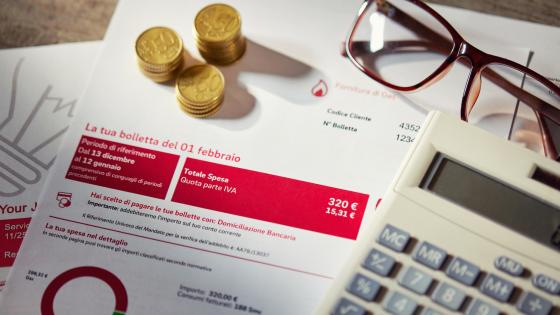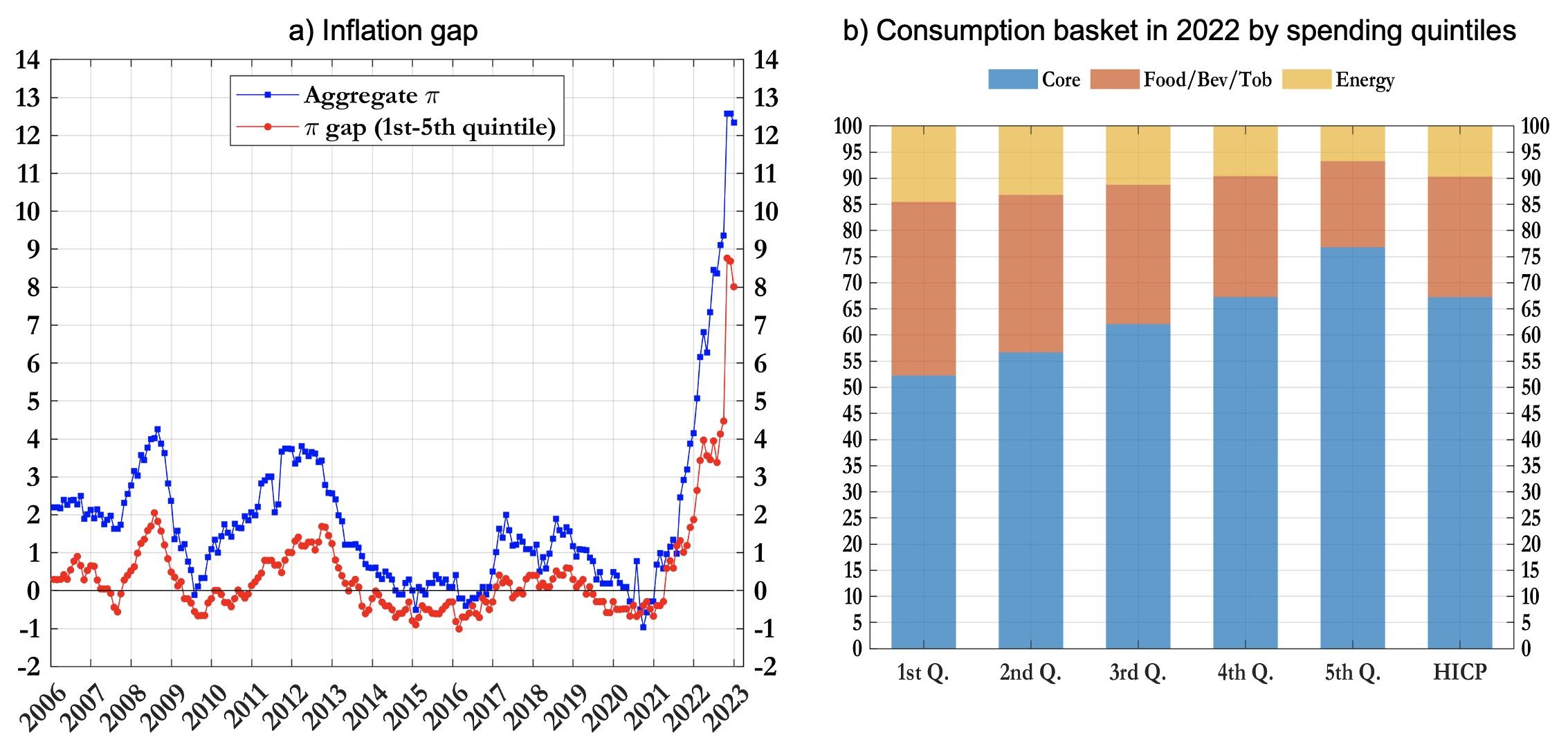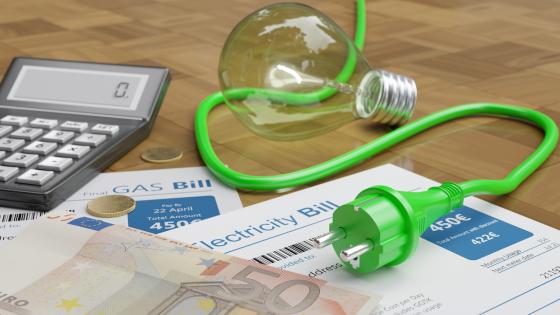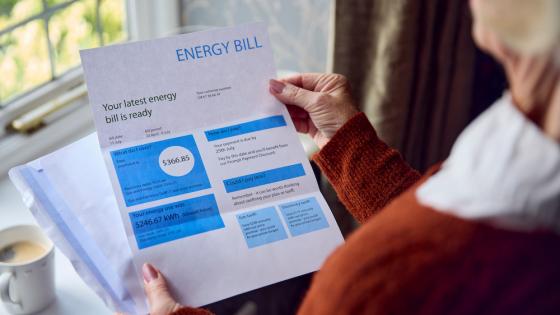The dramatic soaring of energy prices in 2021-2022 has woken inflation after a long era of subdued con-sumer price growth (Neri et al. 2023), but the rise in consumer prices was not equal for all. Inflation is typically considered a regressive tax, as it erodes the purchasing power of vulnerable households more (e.g Erosa and Ventura 2002, Albanesi 2007). Nevertheless, the inflation surge that started in mid-2021, largely driven by skyrocketing energy and food prices, exacerbated the regressive nature of inflation (Känzig 2023).
Available data for Italy shows that the exceptional magnitude of the recent energy price shock has caused a record inflation gap between the bottom and top tails of the expenditure distribution (Figure 1a). The inflation gap, which was close to zero at the beginning of 2021, started rising markedly after that, reach-ing 8.5 percentage points on average in the last quarter of 2022.
Figure 1
Note: Panel a reports the comparison between aggregate headline y-o-y inflation rate and the inflation gap between households in the first and the last quintile (source ISTAT). Panel b shows the composition of items included in the HICP, for the different quin-tiles of households by expenditures and for the entire population in Italy (source ISTAT).
The driver of inflation heterogeneity across households is the different composition of their consumption baskets, with less affluent households spending a much larger share in primary goods. Figure 1b shows that the share of expenditure for food and energy is inversely related to the level of total expenditure. In 2022, the weight of energy in the HICP was 14.6% for households in the first quintile against 6.7% for those in the fifth; the weights of food were 33.2% and 16.5%, respectively. Conversely, core components (services and non-energy industrial goods) represent the bulk of expenditure for more affluent house-holds (76.8%) and only about half of total expenditure (52.2%) for more vulnerable ones. In our recent paper (Corsello and Riggi 2023), we carry out an empirical analysis, based on vector autoregressive mod-els, to quantify the impact of energy price shocks on the inflation gap. A 1% increase in energy inflation leads to an increase in the price gap of around 0.2 percentage points (Figure 2).
Figure 2 Impulse response functions to an energy price shock
Note: Blue shaded areas correspond to the 68% credible regions of the posterior distribution. IRF to an energy shock are normal-ised to yield a 1% impact increase. Responses of CPI and industrial productions are computed as cumulative IRFs.
The upsurge in inflation that occurred in 2022 forced the ECB to start the normalisation of monetary poli-cy that rapidly evolved into a tightening. An unprecedented sequence of policy rate hikes was necessary to avoid second-round effects passing through wages and expectations and to get inflation down to target. In this environment of elevated energy-driven inflation, has the tightening of monetary policy influenced the disparity in inflation rates among households?
Unveiling the role of monetary policy
The demand channel of monetary policy passes through the traction that policy tightening has on spend-ing in the economy. This channel involves mostly core prices rather than energy prices since the latter are more exogenously determined while the former are more elastic to domestic demand. This distinction is particularly pronounced in the post-pandemic period, as energy prices were determined by global factors and amplified by the war in Ukraine, especially in the euro area. Since households in the right tail of the expenditure distribution consume relatively more of the core goods, they also reap more benefits from a stronger monetary policy response in terms of preserving their purchasing power compared with the more vulnerable consumers. To illustrate this channel, we consider a stylised general equilibrium model in which households with different income levels consume different shares of energy and core goods, and the price of energy is exogenously determined. We use Italian data to calibrate the model so that vulnera-ble households represent the first quintile of families in the expenditure distribution. Figure 3 shows the response of the gap between consumer prices for vulnerable and affluent households to a ten per cent in-crease in the price of energy, for different values of the Taylor coefficient on inflation and alternative cali-brations of the policy rate smoothing parameter. Regardless of the degree of monetary policy inertia, a stronger response of monetary policy to inflation causes an increase in the price gap.
Figure 3 Price differential after an energy price shock: The role of the Taylor coefficient on inflation
Note: The figure displays on the y-axis the price gap between vulnerable and affluent households in a calibrated theoretical model, one year after a 10% increase in the nominal price of energy, for different values of the Taylor coefficient on inflation (x-axis). Each line is obtained under a different calibration of interest rate smoothing parameter in the Taylor rule.
In order to investigate the drivers of the changes in inflation inequality observed since the late 1990s, we estimate the theoretical model with Bayesian methods and Italian data. The historical decomposition shows that energy prices are the main driver of the fluctuations in inflation inequality. Nevertheless, changes in the monetary policy stance also played a role in our sample: when monetary policy is accom-modative it provides a negative contribution to the price gap while it pushes up inflation inequality during a tightening.
Focusing on the spike in the price gap in 2022, the direct contribution of monetary policy innovations ap-pears quite limited, as the bulk of the recent increase in inflation inequality was caused by the energy shock. However, the large contribution of this shock embeds not only the mere rise of energy prices but also the subsequent endogenous reaction of macroeconomic variables triggered by the shock.
A counterfactual exercise shows that a sizeable share of this contribution is attributable to the endogenous rise in the ECB’s policy rate. According to the model, the monetary policy tightening in 2022 is entirely due to the energy shock. In the extreme counterfactual scenario in which the policy rate did not respond at all (neither directly nor indirectly) to the energy price increases, the inflation gap between the first and last household quintile in Italy would have been roughly 3 percentage points lower at its peak (8.5 percentage points) in 2022Q4).
Conclusions
It is well known in the literature that the distributional effects of monetary policy pass through a multifac-eted set of real and financial channels, involving income, wealth, and credit capacity (Heathcote et al. 2010, Coibion et al. 2012, Bitler and Hoynes 2015, Bivens 2015, Gnocato 2023). Overall losses and gains, when these channels are considered altogether, may appear more or less evenly distributed across households (Casiraghi et al. 2018, Panetta 2015). Our research stresses that the monetary policy implica-tions on inflation inequality via the heterogeneous consumption basket should deserve more attention, both in the literature and in policy-making. Besides, our findings suggest that fiscal measures targeted to the most vulnerable households should supplement monetary policy in the aftermath of a persistent in-crease in inflation caused by energy prices.
References
Albanesi, S (2007) “Inflation and inequality”, Journal of Monetary Economics 54(4): 1088-1114.
Bitler, M and H Hoynes (2015), “Heterogeneity in the Impact of Economic Cycles and the Great Reces-sion: Effects Within and Across the Income Distribution”, American Economic Review 105(5): 154-160.
Bivens, J (2015) “Gauging the impact of the Fed on inequality during the great recession”, Hutchins cen-ter on fiscal & monetary policy at Brookings, Working Paper No. 12.
Casiraghi, M, E Gaiotti, L Rodano and A Secchi (2018), “A "reverse Robin Hood"? The distributional implications of non-standard monetary policy for Italian households”, Journal of International Money and Finance (85): 215-235.
Coibion, O, Y Gorodnichenko, L Kueng and J Silvia (2012), “Innocent bystanders? Monetary policy and inequality in the US”, IMF Working Paper No. 12/199.
Corsello, F and M Riggi (2023), “Inflation is not equal for all: the heterogeneous effects of energy shocks,” Bank of Italy, Temi di discussione No.1429.
Erosa, A, and G Ventura (2002), “On inflation as a regressive consumption tax”, Journal of Monetary Economics 49(4): 761-795.
Gnocato, N (2023), "Energy Price Shocks, Unemployment Risk, and Monetary Policy", Available at SSRN.
Heathcote, J, F Perri, and G Violante (2010), “Unequal We Stand: An Empirical Analysis of Economic Inequality in the U.S., 1967-2006”, Review of Economic Dynamics 13(1): 15-51.
Känzig, D (2023) “Climate policy and economic inequality”, VoxEU.org, 25 June.
Neri, S, F Busetti, C Conflitti, F Corsello, D Delle Monache and A Tagliabracci (2023), “Energy price shocks and inflation in the euro area”, Bank of Italy, Questioni di Economia e Finanza, No. 792 and SU-ERF Policy Brief, No 710.
Panetta, F (2015), “The Distributional Consequences of Monetary Policy”, remarks at the DNB conference, Amsterdam, 20 November.






